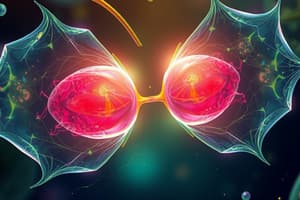Podcast
Questions and Answers
What is the outer layer of a seed called?
What is the outer layer of a seed called?
- Tegemen
- Endosperm
- Testa (correct)
- Cotyledon
Which type of seed has endosperm present to nourish the embryo?
Which type of seed has endosperm present to nourish the embryo?
- Endospermic seed (correct)
- Monocot seed
- Non-Endospermic seed
- Dicot seed
What do non-endospermic seeds lack that is typically present in endospermic seeds?
What do non-endospermic seeds lack that is typically present in endospermic seeds?
- Plumule
- Testa
- Endosperm (correct)
- Cotyledons
Which of the following is a type of endospermic seed?
Which of the following is a type of endospermic seed?
Which part of the dicot seed serves to store food for the developing embryo?
Which part of the dicot seed serves to store food for the developing embryo?
Flashcards
Testa
Testa
The outer layer of a seed. It is tough and protective.
Tegemen
Tegemen
The inner layer of a seed. It is thin and delicate.
Endospermic Seed
Endospermic Seed
A seed that contains endosperm, which provides nourishment to the embryo.
Non-Endospermic seed
Non-Endospermic seed
Signup and view all the flashcards
Albuminous Seed
Albuminous Seed
Signup and view all the flashcards
Study Notes
Seed Formation
- Seeds are formed from a zygote.
- Seeds have two layers.
- The outer layer is called the testa.
- The inner layer is called the tegmen.
Types of Seeds
- Endospermic seeds: These seeds have endosperm. Endosperm is the nutritive tissue that provides nourishment for the developing embryo.
- Albuminous seed or Endospermic seed: Seeds that contain endosperm.
- Non-endospermic seeds: These seeds do not have endosperm. The cotyledons store food for the developing embryo.
- Non-albuminous seed or Non-endospermic seed: Seeds that do not contain endosperm. Food is stored in the cotyledons.
- Some seeds consume all the endosperm.
Seed Types
- Monocot seeds: Monocots have one cotyledon (embryonic leaf).
- Dicot seeds: Dicots have two cotyledons.
- Dicots have a seed coat, hilum (scar where the ovule was attached to the ovary wall), micropyle (a small opening that allows water to enter the seed), cotyledons (seed leaves), radicle (the embryonic root), and plumule (the embryonic shoot).
Studying That Suits You
Use AI to generate personalized quizzes and flashcards to suit your learning preferences.




